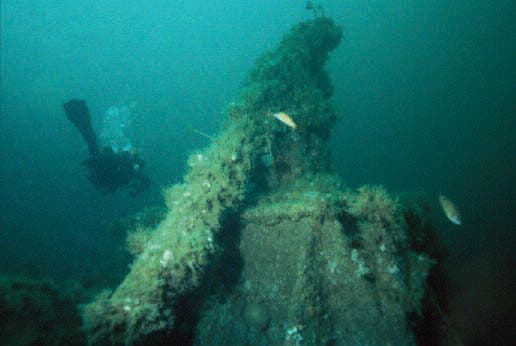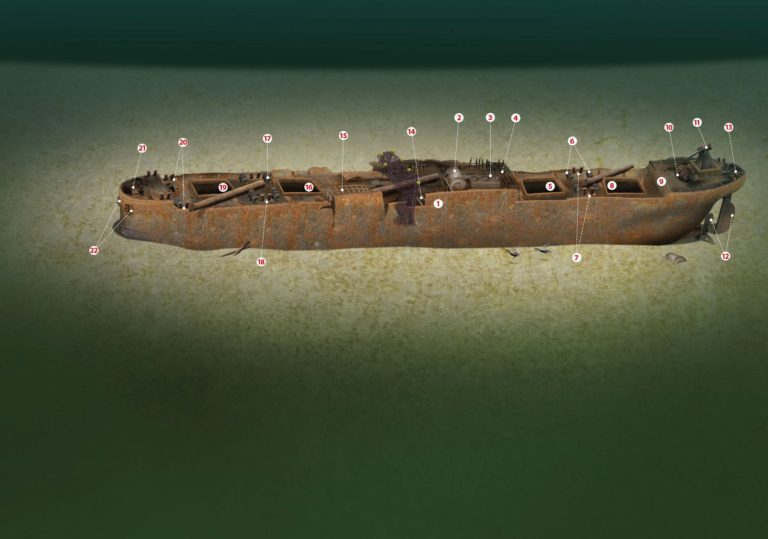Der Untergang dieses französischen Dampfers vor der Bretagne im Jahr 1917, angeblich durch ein lange verschwundenes U-Boot, war Teil eines großen Mysteriums im Ersten Weltkrieg. JOHN LIDDIARD dirigiert die Tour, Illustration von MAX ELLIS
Ich bin MV beigetreten MAUREEN Ich war vor ein paar Jahren auf einer Tour zu den Wracks der Bretagne und am Ende der Reise habe ich alle gefragt, welche Wracks ihnen am besten gefallen haben. Zwei gingen als Sieger hervor: der französische Panzerkreuzer Kleber und das 3272 Tonnen schwere Dampfschiff Sarazenen-, beide Opfer des Ersten Weltkriegs.
Wir haben schon Wrack besichtigt Kleber (44, Oktober 2002), nachdem er sich eine Weile von der Bretagne ferngehalten hat, ist dieser Monat nun an der Reihe Sarazenen-.
Das Wrack liegt im Chenal du Four, berüchtigt für seine starken und instabilen Strömungen. Unter diesen Bedingungen sogar für ein so großes Wrack wie das Sarazenen-Wenn man einen Schuss abgibt, ist es am besten, auf die Mitte zu zielen. Dort beginnt unsere Tour (1), wobei der Schuss an der Backbordseite des Wracks eingehakt ist.
Die Tiefe bis zum Deck beträgt bei Hochwasser etwa 48 m und bei Niedrigwasser einige Meter weniger.

Da es schon eine Weile her ist, seit ich getaucht bin Sarazenen-Ich habe mit Mike Rowley den Zustand des Wracks überprüft. Er teilt mir mit, dass es sich bei der wesentlichen Änderung um ein schweres Schleppnetz handelt, das quer über das Schiff direkt vor den Kesseln quer durch dieses Gebiet verläuft. Daher ist Vorsicht geboten, um sicherzustellen, dass es nicht zu versehentlichen Verwicklungen kommt.
Ungewöhnlich, der Eselskessel (2) ist auf gleicher Höhe mit der Oberfläche des Wracks. Ich kann nur vermuten, dass es sich löste und nach oben schwebte, als das Wrack sank, und sich festklemmte.
Hinter dem Eselkessel liegt die Oberseite des Dreizylinder-Dreifachexpansionsmotors frei, knapp unter dem Niveau der intakten Rumpfseiten (3).
Hinter dem Motor ist eine Winde, die ursprünglich an der Rückseite des Bootsdecks montiert gewesen wäre, teilweise auf das Hauptdeck gefallen (4).
Auch das Hauptdeck selbst begann einzustürzen und sackte nach innen um den Laderaumsüll des ersten Laderaums achtern ab (5). Das robustere Deck zwischen den Laderäumen hat diesen Einsturz mit vier Winden überstanden (6) um den Fuß des Mastes legen. Auf beiden Seiten stehen große Pollerpaare (7).
Der Mast selbst ist achtern und steuerbord über die Ecke des hintersten Laderaums gefallen (8). Wie beim vorherigen Laderaum ist auch hier das Deck eingestürzt, so dass es in Richtung Laderaumsüll durchhängt.
Am Heck steigt das Deck wieder an (9).
Ebenso wie auf der Rückseite des Bootsdecks ist eine weitere Frachtwinde teilweise durch das Deck gefallen (10).

Das Hauptmerkmal am Heck ist das Geschütz, das immer noch montiert ist, aber über die Steuerbordseite herabhängt (11).

Für diejenigen, die flacher als die BSAC-Lufttauchgrenze bleiben möchten, lassen Sie bei Hochwasser den Propeller und das Ruder locker (12) sind auf 54m knapp unerreichbar.
Zurück an Deck, oben am Ruderschaft, ein großer Steuerquadrant (13) füllt den größten Teil des Decks zwischen zwei Pollerpaaren aus.

Bei einem großen und tiefen Wrack muss jede Tour, um alles auf einmal zu sehen, schnell sein. Daher müssen Sie schnell an der Stelle vorbei zurückschwimmen und dabei nach dem Fischernetz in der Mitte des Wracks Ausschau halten. Es ist auch eine gute Idee, den Ort der Aufnahme in dieser Phase des Tauchgangs zu bestätigen, damit Sie später, wenn die Zeit drängt, leichter dorthin zurückkehren können.
Vor dem Eselkessel verdecken die Trümmer des Aufbaus den Hauptkessel weitgehend (14), aber durch einige Lücken im Wrack sind flüchtige Einblicke möglich.
Das Bootsdeck und die Trümmer setzen sich nach vorne fort, wobei die Seiten des Rumpfes beginnen einzubrechen, so dass ein Abschnitt der Reling an der Vorderseite des Bootsdecks nun in das Wrack gekippt ist (15).
Die Decks rund um die vorderen Laderäume ähneln den hinteren Laderäumen (16) hängen nach innen um die Laderaumsülle herum.
Die Windenausrüstung zwischen den vorderen Laderäumen ist mit der zwischen den hinteren Laderäumen identisch und verfügt über vier Winden (17) Stellen Sie sie um den Mastfuß und die Pollerpaare auf beiden Seiten des Decks auf (18).
Diesmal ist der Mast nach vorne und nach Backbord über den vorderen Laderaum gefallen (19).

Das vordere Ende des Hauptdecks ist durch zwei Ankerpoller markiert (20) unmittelbar bevor der Rumpf bis zum Vorschiff ansteigt. Auf dem Vorschiff ist das Deck unter der Ankerwinde eingestürzt und hat die Winde und einige der Poller mitgerissen (21).
Die Ankerketten erstrecken sich noch immer von der Winde durch die Klüsenrohre und halten die Anker auf beiden Seiten des Bugs an Ort und Stelle (22).

Die Möglichkeiten, den Tauchgang zu beenden, hängen vom Skipper ab. Wenn die Anweisungen die Verwendung eines verzögerten SMB vorsehen, ist dies ein guter Ort, um ihn zu starten und weit weg von den Netzen in der Nähe der Kessel abzudriften.
Andererseits kann es bei starkem Strömungsaufbau und langen Dekompressionsstopps erforderlich sein, alle Taucher an einer Dekompressionsstation zusammenzubringen und zum Schuss zurückzukehren.
Danke an Mike, Penny und Giles Rowley.
Von einem Geist versunken
SARAZENEN, Erzträger. GEBAUT 1911, GESENKT 1917
STARK MIT EISENERZ BELADEN, in Bilbao an Bord genommen, das 3272 Tonnen schwere französische Dampfschiff Sarazenen- verließ Spanien mit dem Befehl, es nach Glasgow zu bringen.
Stattdessen Sarazenen- und das Erz landete am zweiten Weihnachtsfeiertag 50 1917 m tief auf dem Meeresboden in der Nähe von Ushant und wurde Teil eines der großen Meeresgeheimnisse des Ersten Weltkriegs. schreibt Kendall McDonald.
Sarazenen- wurde in Sunderland von J Priestman & Co für die Ottoman Line of Newport gebaut und im selben Jahr, 1911, vom Stapel gelassen. Sie war 340 Fuß lang, hatte eine Breite von 48 Fuß und einen Tiefgang von 23 Fuß.
Ihre Dreifachexpansionsmotoren, hergestellt in Großbritannien von George Clark Ltd., sorgten mit 10 Knoten für eine ordentliche Höchstgeschwindigkeit für einen hart arbeitenden Dampfer. Sie hatte die meisten europäischen Häfen besucht, als der Krieg viele davon für sie schloss.
Während der Mittelkriegsjahre Sarazenen- war mit einer großen, aber alten Heckkanone ausgestattet, obwohl es keine Aufzeichnungen darüber gibt, dass sie diese im Zorn abgefeuert hat.
1917 wurde sie an die französische Letricheux-Linie verkauft und arbeitete weiterhin für die Alliierten. Am 23. Dezember segelte sie nach Glasgow, überquerte am nächsten Tag den Golf von Biskaya und machte sich auf den Weg nach Brest.
Am späten Weihnachtstag bog sie in die nördliche Abzweigung des geschwungenen Kanals ein, der in den Schutz von Ushant entlang des von der Flut zerrissenen Chenal du Four führte. Der Kapitän glaubte, dort vor U-Booten sicher zu sein, doch im Licht der Morgendämmerung ließ eine gewaltige Explosion den Backbordbug einstürzen und das Schiff begann, langsam unterzugehen.
Der größte Teil der Besatzung ging zu den Booten und sah, wie das Schiff in einem riesigen Catherine-Rad aus weißem Schaum unter der Wasseroberfläche davonwirbelte.
Der Kapitän und die Besatzung waren sich sicher, dass sie torpediert worden waren, doch das französische Wrackregister vermerkte: „Durch eine von einem deutschen U-Boot gelegte Mine versenkt.“ UC36'.
Hier wird das Geheimnis fast unglaubwürdig. UC36 wird als am oder um den 19. Mai 1917 gesunken gemeldet.
Es besteht kein Zweifel, dass Kapitänleutnant Georg Buch den Befehl erhielt, Minen vor dem Nab Light Vessel und den Needles zu legen, und dass er Zeebrugge am 16. Mai verließ.
Die Minen, die er vor der Nab legte, wurden geräumt, aber vor den Needles wurde nie eine gefunden. UC36 und seine 27 Männer wurden nie wieder gesehen. Britische Aufzeichnungen deuten darauf hin, dass sie möglicherweise durch die Explosion ihrer eigenen Minen versenkt wurde.
Wenn die französischen Aufzeichnungen recht haben und besagen, dass die Mine, die das versenkt hat Sarazenen- war von UC36, seine Minen, mit oder ohne U-Boot, müssen zunächst sieben Monate lang den Kanal hinunter und rund um Ushant herumgetrieben haben. Vielleicht findet jemand auf einer Wracktour die Antwort.
REISEFÜHRER
DAHIN KOMMEN: Vom Ende der M5 fahren Sie weiter nach Süden auf der A38. Biegen Sie links auf die A384 nach Totnes und dann auf die A3122 nach Dartmouth ab. mv Maureen holt vom schwimmenden Steg direkt in das Einbahnstraßensystem ab.
Nach dem Ausladen ist der nächste Langzeitparkplatz der Park-and-Ride-Parkplatz oben auf dem Hügel. Vielleicht haben Sie aber auch das Glück, einen näher gelegenen Parkplatz in einer Seitenstraße zu finden.
So finden Sie es: Die GPS-Position ist 48 25.37 N, 004 52.22 W, das Wrack liegt quer zur Flut mit dem Bug nach Osten.
GEZEITEN: Bei einem typischen Tidenhub von 6 m ist der Durchhang von wesentlicher Bedeutung und fällt mit Hoch- und Niedrigwasser in Brest zusammen.
TAUCHEN, UNTERKUNFT & LUFT: mv Maureen, Kapitän Mike Rowley, 01803 835449, Professionelle Tiefsee-Charterboote
QUALIFIKATION: Tiefe und Strömung erfordern, dass Taucher in Dekompressionsverfahren qualifiziert sind und über beträchtliche Erfahrung verfügen, um dies zu belegen TAUCHERAUSBILDUNG.
WEITERE INFORMATIONEN: Admiralitätskarte 3345, Chenal du Four.
Pluspunkte: Bemerkenswert intakt für ein Wrack aus dem Ersten Weltkrieg, ohne Anzeichen einer Bergung.
CONTRA: An der Grenze des Lufttauchens, mit starken Gezeiten und kurzem Stillstand.
TIEFE: 45m +
PDF-Version des The Saracen Wreck
Erschienen in DIVER November 2007


